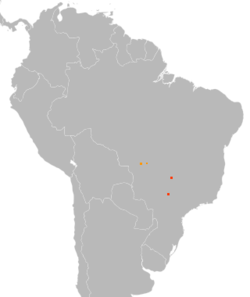Blue-eyed ground dove
Species of bird From Wikipedia, the free encyclopedia
The blue-eyed ground dove (Columbina cyanopis) is a species of bird in the family Columbidae. It is endemic to the Cerrado region of Brazil.[2]
| Blue-eyed ground dove | |
|---|---|
 | |
| Blue-eyed ground-dove | |
| Scientific classification | |
| Domain: | Eukaryota |
| Kingdom: | Animalia |
| Phylum: | Chordata |
| Class: | Aves |
| Order: | Columbiformes |
| Family: | Columbidae |
| Genus: | Columbina |
| Species: | C. cyanopis |
| Binomial name | |
| Columbina cyanopis (Pelzeln, 1870) | |
 | |
| Approximate ranges
Extant (resident) | |
| Synonyms | |
| |
Taxonomy and systematics
The blue-eyed ground dove was for a time placed in the monotypic genus Oxypelia. That genus was merged into Columbina by the 1960s. Some plumage features set it apart from other Columbina species and more closely resemble those of the blue ground dove (Claravis pretiosa). The blue-eyed ground dove is monotypic.[3][4][2]
Description
The blue-eyed ground dove is 15.5 cm (6.1 in) long. The male's head, neck, wing coverts, uppertail coverts, and breast are purplish red. Its lower breast, belly, flanks, shoulders, and back are browner. Its vent and undertail coverts are white. The closed wing shows dark brown and chestnut with iridescent blue spots. The central tail feathers are rufous and the outer ones darker. Its eye is blue surrounded by bare gray skin. The adult female is paler, especially on its underparts. The juvenile has rufous edges on many feathers and the wing's spots are obscure.[4]
Distribution and habitat

The blue-eyed ground dove inhabits open savannah and grasslands in the Brazilian cerrado.[4] The only reliable records since 1980 are in the states of Minas Gerais, Mato Grosso, and Mato Grosso do Sul, and only in the first of these have any been seen since 2007. There are historical records of specimens from Mato Grosso in the early 1800s, São Paulo in 1904, and Goiás in the early 1940s.[1]
The species was rediscovered in 2015, and about 27 individuals among the only known population were left in 2017.[5] In 2023, the chicks of this species was reared in captivity for the first time.[6]
Behavior
Feeding
No information on the blue-eyed ground dove's feeding behavior or diet has been published. It presumably feeds on seeds like the others of its genus.[4]
Breeding
No information is available on the blue-eyed ground dove's breeding phenology.[4]
Vocalization
The blue-eyed ground dove's song is "a series of evenly-spaced, soft cooing notes" rendered as "wah", "wuh" or "prrah".[4]
Status
The IUCN has assessed the blue-eyed ground dove as Critically Endangered. "This species is very rare with only few recent records, suggesting that the total population is extremely small. [1] A continuing decline is inferred from rapid rates of habitat loss in the region. The Cerrado region in Brazil has become more of a pasture land, leading to difficulty for the doves trying to access the resources on the ground. The wild dogs and threats keep the doves away, which researchers believe is a major factor in the species endangerment." [7]
References
External links
Wikiwand - on
Seamless Wikipedia browsing. On steroids.


